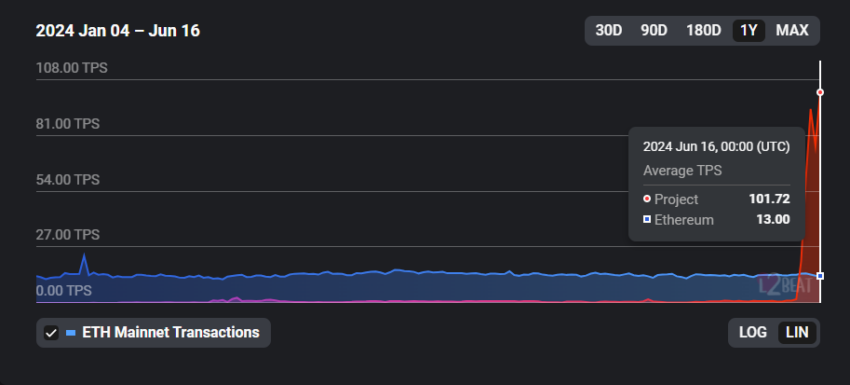ARTICLE AD BOX
The Ethereum ecosystem recently saw an unprecedented surge in transactions per second (TPS). According to L2beat data, on June 16, Ethereum’s scaling networks, including both layer-2 (L2) and layer-3 (L3) solutions, achieved a combined 245.87 TPS. This figure translates to approximately 21.2 million transactions in a single day.
Interestingly, this surge was driven by the achievements of Xai, a new Ethereum L3 solution.
Xai’s Rise Marks a New Era in Ethereum Scalability
Xai is an L3 solution powered by Offchain Labs, the creators of the Arbitrum One blockchain. This protocol focuses on gaming applications.
Since June 12, Xai has seen a meteoric rise in TPS, from just one transaction per day to an impressive 101.72 TPS on June 16. Xai’s recent performance has also set new standards for the highest daily TPS among L2 and L3 solutions in the Ethereum network.
Read more: A Beginner’s Guide to Layer-2 Scaling Solutions
 Xai TPS. Source: L2Beat
Xai TPS. Source: L2BeatMoreover, Xai surpassed Degen Chain’s April record for the highest TPS rate within the ecosystem. Following Xai, Base is second with 32.97 TPS, and Arbitrum came in third, marking 20.65 TPS as of June 16.
Despite the impressive TPS numbers, the total value locked (TVL) in Xai remains modest at $1.33 million. This figure contrasts sharply with Arbitrum One and Base, which hold $17.78 billion and $7.54 billion, respectively.
Xai’s new achievement highlights the significant role of L3 solutions in enhancing Ethereum’s scalability. The emergence of L3 technologies has sparked discussions about their being a critical component in blockchain technology infrastructure. Many believe L3 can improve the scalability and efficiency of blockchain networks and facilitate the creation of new decentralized applications (Dapps).
L3 technologies represent a groundbreaking stride beyond the existing layer-1 (L1) and L2 solutions. L1, the blockchain base layer like Ethereum, provides fundamental security and decentralization.
Meanwhile, L2 operates on top of L1 to enhance scalability. On the other hand, L3 aims to further scale blockchain networks by anchoring them into L2 for security. This potentially offers exponential scalability benefits.
In his 2022 blog post, Vitalik Buterin, the co-founder of Ethereum, discussed the potential of L3 technologies. He explained that L2 is primarily for scaling, while L3 is for customized functionality like privacy.
“In this vision, there is no attempt to provide ‘scalability squared’; rather, there is one layer of the stack that helps applications scale, and then separate layers for customized functionality needs of different use cases,” Buterin wrote.
Buterin elaborated that L3, which is for customized scaling, might come in different forms. He pointed out specialized applications that use something other than the EVM (Ethereum Virtual Machine) for their computation or rollups optimized for specific data formats, for example. He also mentioned the potential of validiums, systems using SNARKs for computation verification but relying on trusted third parties for data availability, as a viable L3 solution.
However, some industry experts criticize the discourse around L3, including Marc Boiron, CEO of Polygon Labs, the company behind the L2 project Polygon. Boiron argues that L3 may siphon value from Ethereum’s ecosystem to the L2s they build upon.
Read more: What Is Validium and How Does it Make Ethereum More Scalable?
Despite varying viewpoints, the discussion around L3 and its potential remains among the most fascinating topics in the decentralized finance (DeFi) industry. As L3 is still in its early stages, its effectiveness and impact are yet to be fully realized. The industry will closely watch how L3 solutions like Xai develop and shape the future of Dapps and scalability.
The post Ethereum’s Layer-3 Solution Xai Achieves 101.72 Transactions per Second, Breaking Records appeared first on BeInCrypto.
.png)
 5 months ago
2
5 months ago
2








 English (US)
English (US)